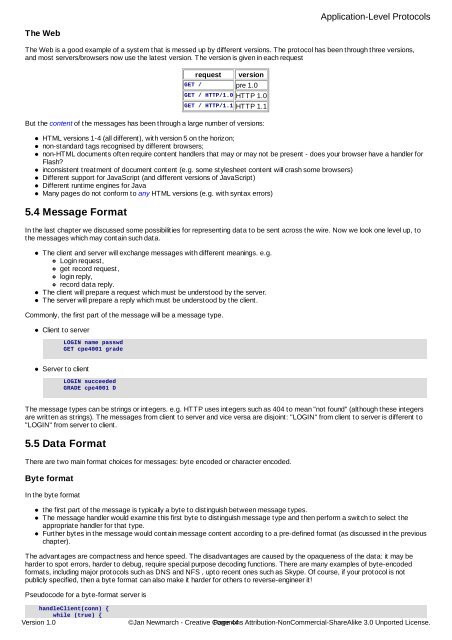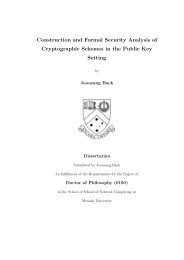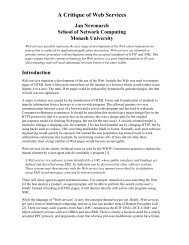Network Programming with Go - Jan Newmarch
Network Programming with Go - Jan Newmarch
Network Programming with Go - Jan Newmarch
You also want an ePaper? Increase the reach of your titles
YUMPU automatically turns print PDFs into web optimized ePapers that Google loves.
The Web<br />
The Web is a good example of a system that is messed up by different versions. The protocol has been through three versions,<br />
and most servers/browsers now use the latest version. The version is given in each request<br />
request version<br />
GET / pre 1.0<br />
GET / HTTP/1.0 HTTP 1.0<br />
GET / HTTP/1.1 HTTP 1.1<br />
But the content of the messages has been through a large number of versions:<br />
HTML versions 1-4 (all different), <strong>with</strong> version 5 on the horizon;<br />
non-standard tags recognised by different browsers;<br />
non-HTML documents often require content handlers that may or may not be present - does your browser have a handler for<br />
Flash?<br />
inconsistent treatment of document content (e.g. some stylesheet content will crash some browsers)<br />
Different support for JavaScript (and different versions of JavaScript)<br />
Different runtime engines for Java<br />
Many pages do not conform to any HTML versions (e.g. <strong>with</strong> syntax errors)<br />
5.4 Message Format<br />
In the last chapter we discussed some possibilities for representing data to be sent across the wire. Now we look one level up, to<br />
the messages which may contain such data.<br />
The client and server will exchange messages <strong>with</strong> different meanings. e.g.<br />
Login request,<br />
get record request,<br />
login reply,<br />
record data reply.<br />
The client will prepare a request which must be understood by the server.<br />
The server will prepare a reply which must be understood by the client.<br />
Commonly, the first part of the message will be a message type.<br />
Client to server<br />
LOGIN name passwd<br />
GET cpe4001 grade<br />
Server to client<br />
LOGIN succeeded<br />
GRADE cpe4001 D<br />
The message types can be strings or integers. e.g. HTTP uses integers such as 404 to mean "not found" (although these integers<br />
are written as strings). The messages from client to server and vice versa are disjoint: "LOGIN" from client to server is different to<br />
"LOGIN" from server to client.<br />
5.5 Data Format<br />
There are two main format choices for messages: byte encoded or character encoded.<br />
Byte format<br />
In the byte format<br />
the first part of the message is typically a byte to distinguish between message types.<br />
The message handler would examine this first byte to distinguish message type and then perform a switch to select the<br />
appropriate handler for that type.<br />
Further bytes in the message would contain message content according to a pre-defined format (as discussed in the previous<br />
chapter).<br />
The advantages are compactness and hence speed. The disadvantages are caused by the opaqueness of the data: it may be<br />
harder to spot errors, harder to debug, require special purpose decoding functions. There are many examples of byte-encoded<br />
formats, including major protocols such as DNS and NFS , upto recent ones such as Skype. Of course, if your protocol is not<br />
publicly specified, then a byte format can also make it harder for others to reverse-engineer it!<br />
Pseudocode for a byte-format server is<br />
Application-Level Protocols<br />
handleClient(conn) {<br />
while (true) {<br />
Version 1.0 ©<strong>Jan</strong> <strong>Newmarch</strong> - Creative Commons Page 44 Attribution-NonCommercial-ShareAlike 3.0 Unported License.




